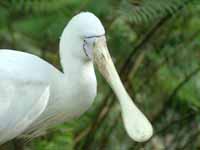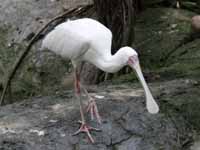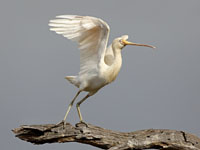THE WORLD BIRDS - An Online Bird Book
Order Pelicaniformes
The Pelicaniformes currently contain the pelicans (Pelecanidae), herons (Ardeidae), spoonbills and ibises (Threskiornithidae), Hammerkop (Scopidae), and shoebill (Balaenicipitidae). This order may need to be separated into additional orders as the similarities of these families may be due to convergent evolution and not common ancestors.
Spoonbills
Order Pelicaniformes Family Threskiornithidae
Order Pelicaniformes
The Pelicaniformes currently contain the pelicans (Pelecanidae), herons (Ardeidae), spoonbills and ibises (Threskiornithidae), Hammerkop (Scopidae), and shoebill (Balaenicipitidae). This order may need to be separated into additional orders as the similarities of these families may be due to convergent evolution and not common ancestors.
Spoonbills
Order Pelicaniformes Family Threskiornithidae
Ibises and Spoonbills are closely related. Their most striking difference is in bill shape, with the Ibises having curved bills and the Spoonbills having straight bills that are broad at the end. Ibises use their bills to probe in mud, while Spoonbills move their side to side in the water to catch prey. At night they roost in trees that are near and often overhanging water.
Ibises and Spoonbills have recently been placed in the same order as Pelicans and Herons. Stay tuned!
Genus Platalea
Spoonbill, African Platalea alba Found: Africa
The breeding African Spoonbill has mainly white plumage; red face, legs; gray bill. Juveniles lack the red face and have a yellow bill.
Image by: 1) Dick Daniels - St. Lucia, South Africa 2) Dick - San Diego Zoo
3) Dick - Birds of Eden, South Africa 4) Charlie Westerinen - Zimbabwe 5) Nik_Borrow - Uganda


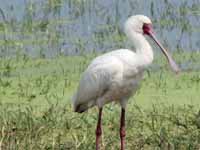
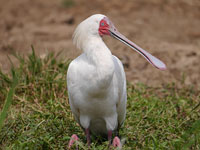
Spoonbill, Black-faced Platalea minor Found: coastal areas of eastern Asia
The Black-faced Spoonbill has mainly white plumage; black of face surrounds eyes and forehead; black bill; dark legs. Breeding has yellow breast-patch; white crest.
Similar to: Eurasian Spoonbill. Breeding Eurasian Spoonbill has yellow-tipped black bill; breeding Black-faced Spoonbill has black bill with no yellow tip. Black-faced Spoonbill has black face.
Image by: 1) Charles Lam 2) Darren Bellerby - Hong Kong Wetland Park, Hong Kong 3) Cp9asngfSimilar to: Eurasian Spoonbill. Breeding Eurasian Spoonbill has yellow-tipped black bill; breeding Black-faced Spoonbill has black bill with no yellow tip. Black-faced Spoonbill has black face.
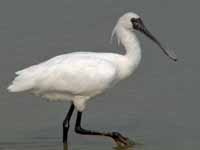
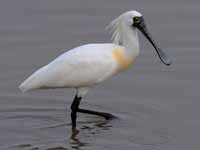
Spoonbill, Eurasian also Common Spoonbill Platalea leucorodia Found: Europe, Asia, Africa
The breeding Eurasian Spoonbill has mainly white plumage; yellow breast-patch; black bill with yellow tip; dark legs; crest. Nonbreeding lack crest and breast-patch.. Juvenile has pale bill; black tipped primary feathers.
Similar to: Black-faced Spoonbill. Breeding Eurasian Spoonbill has yellow-tipped black bill; breeding Black-faced Spoonbill has black bill with no yellow tip. Black-faced Spoonbill has black face.
Image by: 1) Creando 2) Bhardwaj Shanthanu - India 3) Iacopo
lea - Italy 4) Andreas Trepte 5) Cristiano Crolle - Texel, Holland Similar to: Black-faced Spoonbill. Breeding Eurasian Spoonbill has yellow-tipped black bill; breeding Black-faced Spoonbill has black bill with no yellow tip. Black-faced Spoonbill has black face.
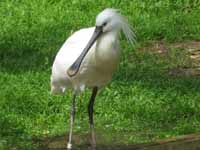
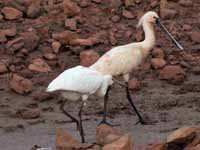
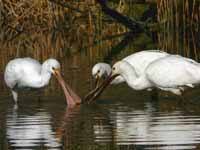
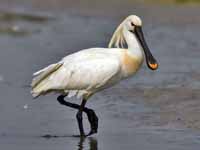

Spoonbill, Roseate Platalea ajaja also Ajaia ajaja Found: The Americas
The Roseate Spoonbill is the only spoonbill found in the Americas. It is easy to identify because of its spoon-like bill. It has pink plumage which varies in color depending on diet and age; gray bill.
Image by: 1, 3) Dick Daniels - Ding Darling National Wildlife Refuge, Sanibel Island, Florida
2) Sandy Cole - Flamingo
Gardens, Flroida 4) Sandy Cole - Sylvan Heights 5) Dick - San Francisco Zoo 6) Dick - San Diego Zoo 7) Dick - National Aviary 8) Dominic Sherony
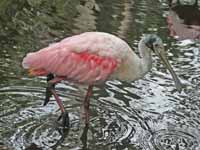

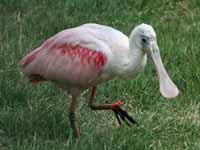
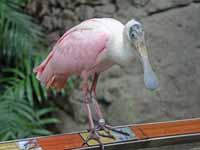

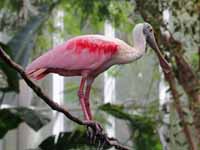
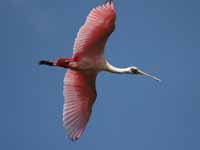
Spoonbill, Royal also Black-billed Spoonbill Platalea regia Found: Australia, New Zealand and some Pacific Islands
The Royal Spoonbill has white plumage; black bill, legs.
Image by: 1, 3, 4) Dick Daniels - Australia 2) Dick - Australia 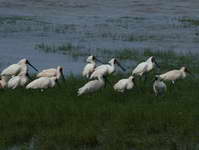
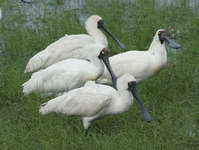
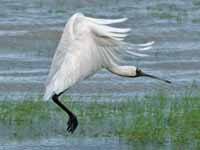
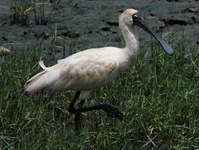
Spoonbill, Yellow-billed Platalea flavipes Found: Australia
The Yellow-billed Spoonbill has white plumage; yellowish bill, legs, feet.
Image by: 1) Petr Baum - Zoo in Healesville, Victoria 2, 3) Sandy
Cole - San Diego Zoo 4) patrick kavanagh